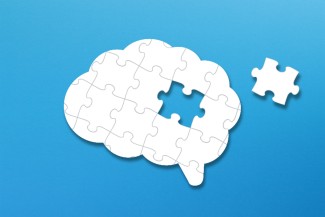The progressive deterioration of nerve cells (neurons).
The human central nervous system (brain and spinal cord) is made up of around 2 trillion cells, including 100 billion neurons (i.e. 5%)
Though science typically divides the brain into different function areas (motor, visual, emotional), it is now clear that several brain regions are involved in carrying out a motor task or an emotional reaction, making it even more difficult to assign a specific role to one region of our brain and the effects of a malfunction in this region.
Neurons are the brain cells that allow the brain to orchestrate all of this.
Neurons consist of three separate sections, each with their own individual roles.
• The cell body, which acts as the ‘checkpoint’ and takes on information.
• The axon, which is the section that transmits messages, and in which nerve impulses are passed to other neurons or other cells, such as muscle cells. It is surrounded by a protective sheath that allows nerve impulses to pass more rapidly – the myelin.
• The dendrites, extensions that receive nerve messages emitted by other neurons.
On average, a neuron is capable of communicating with 10,000 other neurons with the same function, creating networks that can be activated or deactivated depending on our brain activity.
Neuron death
Neurodegeneration refers to the process of neuron deterioration. Because it is very hard to regenerate neurons for several reasons, they lose their function over time or die.
Neuron death has a range of different consequences, but the brain is able to compensate for the loss of certain neurons using mechanisms like redundancy (having more neurons available than necessary), the ability to form new connections and the production of new neurons, particularly in the hippocampus.
Why and how do neurons die?
Whatever the type of neuron, wherever it is located, whichever proteins neurotransmitter it uses to communicate, and whatever its function, there is a common mechanism of degeneration known as the toxic aggregation of proteins. Proteins are encoded by our genetic inheritance, our DNA, and play a wide range of vital functions in cells and organs. They support the structure of the cell itself (they enable muscle cell mobility, for example), and are essential for energy metabolism and the transmission of information between cells, such as nerve impulses. Proteins have a three-dimensional structure that depends on their composition and which allows them to perform their biological function. Some proteins can take on an abnormal shape, but this is then corrected or eliminated by ‘control’ systems.
However, in some conditions that are still not fully understood, abnormal proteins can accumulate and aggregate, forming oligomers, which, in turn, aggregate to form fibrils inside the neurons or on their periphery. These abnormal protein aggregates are then impossible for the brain to destroy, and become toxic to neurons by as yet unidentified mechanisms, but for which three hypotheses are being studied:
- neuron death is caused by the loss in activity of these proteins essential to their survival
- the protein aggregates create a new function toxic to the neuron
- the presence of abnormally aggregated proteins activates an inflammatory reaction that leads to neuron death.
Neurodegenerative diseases
Certain diseases are linked to neurodegeneration. These include:
Other words that might interest you.
- Neuron :
- Basic cell of the nervous tissue, capable of receiving, analysing, reproducing and transmitting information in the form of an electrical or chemical signal.

